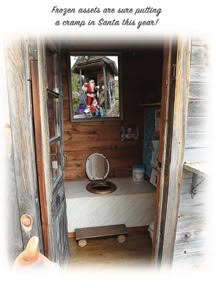Seasons Greetings from the Privy
Privies Enduring Symbol
Holiday Season Outhouse
by Back Roads Bill
Full Christmas Card Christmas images pdf
The ground is almost frozen but not everywhere, not in an outhouse anyway. And I wanted to match the Back Roads holiday season greeting card with a story.
 One of the rural ways of life’s most enduring symbols has been the outhouse and you can see them on the back roads. It also goes under the name of back house, john, the wee or little house, the house of parliament , the inconvenience or the privy. “Thunder boxes” without the protective shed are most often found along canoe routes at designated Ontario Parks’ campsites.
One of the rural ways of life’s most enduring symbols has been the outhouse and you can see them on the back roads. It also goes under the name of back house, john, the wee or little house, the house of parliament , the inconvenience or the privy. “Thunder boxes” without the protective shed are most often found along canoe routes at designated Ontario Parks’ campsites.
Outhouse owners take advantage of this self-supporting abode to sit and browse through magazines and the shopping flyers within ‘Community Voices.’ In the past, Sears and Eaton’s catalogues were the reading material of choice. It’s actually a tribute to the popular makeshift toilet paper of the past. The farmers would take these catalogues and when they were done with them, put them out in the outhouse and use them to wipe with.
Then and Now
The outhouse originated about 500 years ago in Europe, and was used primarily at inns or in public spaces. During this time, the ubiquitous symbol of the crescent moon on the outhouse door also began to appear. Since most people were illiterate during this time, the male outhouses were marked with the symbol of a sun, indicating masculinity, and the women’s were marked with a symbol of a crescent moon, which represented the feminine (also the Roman goddess Diana who was the protector of women). Eventually, outhouses became unisex and some even included several different sized holes for men, women and children.
With the ongoing movement toward organic this, organic that, and composting, the pit privy is making a comeback in rural Canada. At the same time because of the Walkerton tragedy, the awareness of water quality and water resources being close to various forms of bacteria, like coliform, has become of paramount importance.
Outhouses work very simply: a seating area inside is open to a pit dug into the ground. When solid and liquid wastes are introduced to the pit, natural organisms in the soil, bacteria and insects consume nutrients in the waste material. This helps the waste decompose and form compost inside the pit. As long as the input of waste does not exceed the rate of decomposition, the material will be composted and will not contaminate any local groundwater. Despite this simplicity some experts were needed.
Water and Waste 101
To dig deeper into this vital holiday topic Chuck Poltz a Public Health Inspector with North Bay Parry Sound District Health Unit was contacted.
Chuck reminds us about the basics of our indoor plumbing. Within a standard household 30% of water usage is for flushing toilets, bathing and showering accounts for roughly 35% and all other uses make up the last 35%. A standard toilet uses around 18 litres (l) of water per flush and low flow toilets come in around 12 l.
“In North Bay, for example, the average daily water usage for the city for 2014 was 28,000 cubic meters per day (that’s 28 million l of water!) If we take 30% of that as a very rough estimate we are talking about almost 10 million l of treated potable water per day used to get feces from your house to the sewage treatment plant” he said.
“One major advantage is that an outhouse or privy is specialized in the material that it deals with – it only has to treat human wastes, and not all the other detergents and soaps, and chemicals that go down drains,” said Chuck. “Outhouses are a good way of treating sewage, but they certainly are not the solution to every situation. They do not work well in areas of high population density or in areas where the ground is wet or there is a high groundwater table. They rely on being able to allow the water to be filtered out in the soil. They also don’t work if you are on bedrock or have very little soil.”
How much water does an outhouse use? None, but is it effective at treating the waste? They can be very effective in the right conditions. “You have to remember that the decomposition requires biological action- bacteria and protozoans and insects and worms. All these creatures have their requirements for living conditions and preferred conditions. Which is why not a lot of decomposition happens at -40 C ; things just pile up and there may be some physical breakdown of materials due to freeze-thaw cycles, but the real work waits until spring. A lot of the same microbes are used in a sewage treatment plant, but the volumes, the flow and the heat produced by decomposition keeps things working , so there are some economies of scale. This is one good reason to dig an outhouse pit as deep as you can go as that way the warmth from the earth can keep the processes moving along, even if it is greatly slowed down.” So dig deep, but there is more to know.
“One of the other factors is aeration- a well aerated system will decompose much faster and will create less odour,” he said. You can see the difference in a well-built privy where the urine and other moisture can go away through the soil, and a vault privy, like the roadside ones where everything is trapped and they have to be pumped out on a regular basis. The vault privies will most often smell much worse than the earth pit variety.
He said, “Fecal coliform reduction happens by biodegradation or desiccation primarily. In the research these are indicators and do not represent all the different types of organisms: viruses, parasites, molds, and other bacteria, some of which may be much more resilient.”
In some research they have determined that the ideal mix of carbon to nitrogen is between 15:1 and 30:1 . The ratio of carbon to nitrogen in human feces is typically closer to 5:1 , so the addition of carbon rich materials like sawdust will speed up the decomposition.
In the end the question of how well an outhouse works at degrading and composting feces comes down to a number of factors: soils , temperature, water content, materials put into it- in terms of types and volume. “Essentially, they are what composting toilets are mimicking, with more controls for temperature, aeration, and ventilation. The higher heat in many composting toilets also is more effective at killing off pathogens instead of relying on natural heat production, dehydration, and competition to kill them off. In essence the treatment systems in field beds and municipal sewage treatment systems all use the same principles as well, but with water used to move the sewage around, and then at some point it has to be dewatered to remove the solids.”
More Wisdom
Brenda McClay is the owner of Near North Laboratories; she echoes similar sentiments. “The great thing about a privy is that is doesn’t use water, it has a small footprint and it’s a natural process.”
She said, “Make sure there is enough soil depth above the water table for filtration and attenuation of nutrients; and that the soil is of a nature to chemically bond nutrients and prevent them from migrating freely to a water way, lake, creek, river or from getting into a drinking water well. So building an outhouse on 2 feet of sand overburden on bedrock would likely not be a good idea when proximate to a water way or well. Also, it would be important to not dump anything down the pit that shouldn’t be there – no chemical or industrial wastes. People should think of pits like coarse filters rather than traps.”
And a couple of logistical stories from Brenda to ponder. “One, don’t (from experience) plant holly hocks around an outhouse. My Mom thought that would be a lovely improvement one year except they are a tall flower that attracts bees. With the vent screening not being perfect, trips to the outhouse involved careful consideration of where one was in relation to the abundance of bees that flew in and out of the screening overhead.” And, “It’s also important to have a secure base around the outhouse to prevent rabbits from accidentally falling in, not my story to tell – this belongs to a friend of mine.” (Important to note, the rabbit was eventually saved.)
Randy and Cindy Lalande returned to their pioneer roots more than twenty years ago and have not one but two outhouses (one is a two-holer) on their Powassan farm. “It is serious business,” Randy says. “To begin with the pit should be large enough to last for a few years, before it starts to fill up, allowing fro normal drainage and decomposition. If the soil is too sandy it will have to shored to prevent cave-ins. If it’s solid clay the liquid will just sit.”
 Cindy recommends “rigid construction” that includes a “good door,” windows and screens to match the seasons and metal sheeting on the outside walls, closest to the ground, to discourage porcupines.” She suggests a cup of lime “every now and then” and a “stir” to complement the decomposition process.
Cindy recommends “rigid construction” that includes a “good door,” windows and screens to match the seasons and metal sheeting on the outside walls, closest to the ground, to discourage porcupines.” She suggests a cup of lime “every now and then” and a “stir” to complement the decomposition process.
There’s an outhouse capital of the world. It’s a curious claim to fame but American town Elk Falls calls itself the outhouse capital of Kansas and even the world. On the Friday and Saturday before American Thanksgiving, Elk Falls holds outhouse tours promise “an outrageously ‘moving’ experience,” as people wander through wacky homemade outhouses and vote for their favourites. Last year’s winner was the very pink “pretty privy” with lace curtains and a frilly table lamp. Anyway, I hope you get to use an outhouse during the holidays. My favourite line from ‘Ode to the Outhouse,’ “…The torture of that icy seat would make a Spartan sob…”
